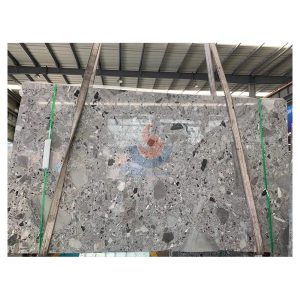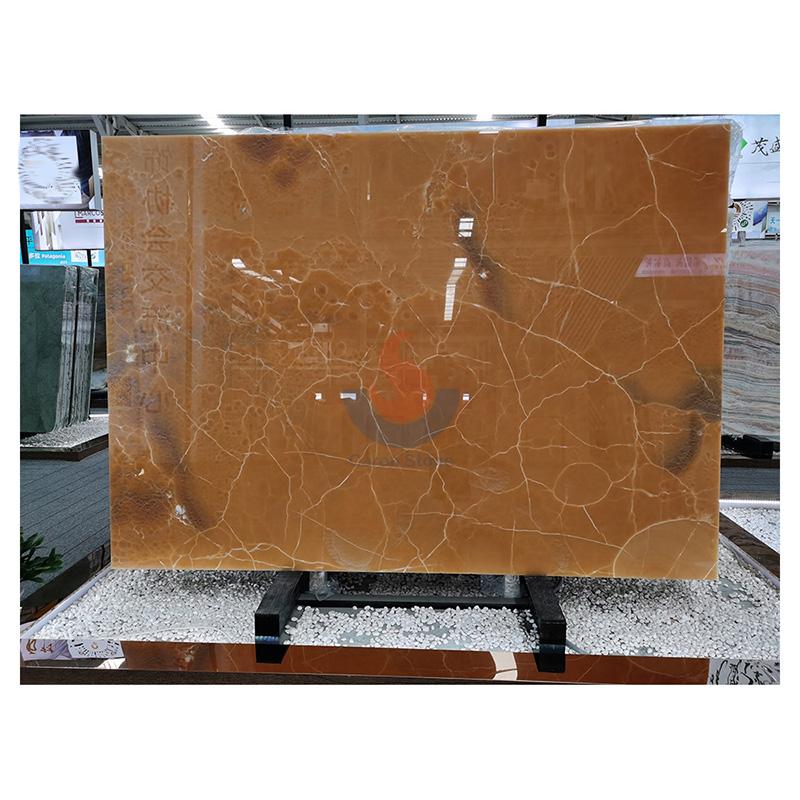Why does natural marble have so many colors? Natural stone is known to be produced from several kinds of minerals. The several kinds and ratios of mineral components found in natural stone help to explain its vivid colours and patterns. For instance, marble has various minerals and its main component in consolidation is calcium carbonate. Marble presents such beautiful colours because these sticky minerals melt into calcium carbonate during the production of the stone. And these sticky minerals are also natural colours for natural stones such granite, slate, travertine (travertine), sandstone, etc.

Natural Terrazzo Fossil Grey Marble Big Slab Engineered Size Marble
The deep charm of black marble
Black: carbon, biotite, hornblende
Black marble has become a distinctive choice in design because of its rich colour and strong abstract expression. Marble gains its enigmatic and noble black from the inclusion of minerals including carbon, hornblende, and biotite. Black marble can produce a quiet and understated environment in space design. Its application can sometimes become a visual focal point, displaying a depth and force transcending human comprehension.
Warm and retro in brown marble
Brown: limonite.
Brown marble makes one warm and retro since of its unusual colour and texture. The presence of minerals like limonite gives brown marble a rich coffee tone, as if a cup of hot cocoa given in the cold, warm and pleasant. Like the vestiges of time, the texture of brown marble gives the space historical gravity and vintage elegance.
Low-key luxury of gray marble
Gray: various minerals
With its low-key and trendy hue, grey marble has grown in popularity recently in upscale homes and businesses. Grey marble frequently consists of several mineral components, and the combination of different minerals gives marble a rich sensation of layering and mystery. The use of gray marble can bring a modern and luxurious atmosphere to the space, and it can also be well matched with other colors and materials, showing a simple but not simple aesthetics.
Green marble’s natural freshness
Green: mica; silicate, chloride;
Fresh and natural colours of green marble have made it a common choice for interior design. The minerals mica, chloride, and silicate give green marble a vivid green colour akin to a gift from nature. In house decoration, the use of green marble may not only add a fresh and natural feeling to the room, but also generate a dreamy mood, so making people feel as if they are in a tranquil natural environment.
The passion and unrestrainedness of red marble
Red: Hematite
Red marble, with its bright colors and warm emotions, has become a strong expression in design. Minerals like haematite provide marble its passionate and unbridled red colour. Red marble is a common tool used in space design to draw people’s attention and create a strong and passionate mood. Like a flame, red marble’s colour radiates warmth and cosiness for the surroundings.
The purity and elegance of white marble
White: feldspar, calcite, dolomite
White marble, with its pure and elegant color, has become a classic choice in interior decoration. White marble found in presence of minerals like feldspar, calcite, and dolomite has a soft and natural white. In space design, white marble may not only provide the room with a sense of purity and tranquilly but also blend nicely with other colours and materials, so presenting a simple and elegant look.
The noble warmth of yellow marble
Yellow; limonite
Modern design has evolved to favour yellow marble because of its subdued colour and honourable attitude. The presence of minerals like limonite helps yellow marble show a warm golden colour, like sunlight, thereby filling the area with a brilliant and pleasant impression. In home decoration, the use of yellow marble can not only add a sense of nobility and wealth to the space, but also create a warm and comfortable atmosphere.

Real natural Blue onyx marble stone slab and tile for wall and floor contruction decoration from China
Through these extensions, we can see that the reason why natural marble can present such a variety of colors and textures is precisely because of the diversity and complexity of its mineral components. Marble is extensively utilised in architectural design and interior decorating since these several mineral components not only offer it distinctive colours and textures but also provide designers a large creative area.





